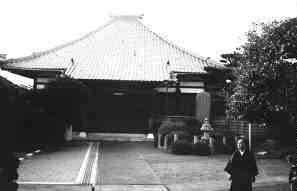The Salad Bowl.
Vol. VI, No. 1. Jan. 1998. p. 1 - 4.
(Historic Sites in Shizuoka)
Myoukeiji Temple
 The Imagawa family held control over a portion of central Japan from 1337 until 1560. Ironically this family reached its nadir just before its downfall. In 1536 when Imagawa Yoshimoto became family head, his fiefdom was limited to central Shizuoka prefecture. Over the next two decades, he successfully expanded the domain across much of Shizuoka and Aichi prefectures. When his troops clashed with Oda Nobunaga's at Okezama in May 1560, it became clear Imagawa made one fatal error: he underestimated the power of firearms.
The Imagawa family held control over a portion of central Japan from 1337 until 1560. Ironically this family reached its nadir just before its downfall. In 1536 when Imagawa Yoshimoto became family head, his fiefdom was limited to central Shizuoka prefecture. Over the next two decades, he successfully expanded the domain across much of Shizuoka and Aichi prefectures. When his troops clashed with Oda Nobunaga's at Okezama in May 1560, it became clear Imagawa made one fatal error: he underestimated the power of firearms.
A few years before Lord Imagawa's demise, one of his daughter's passed away and a temple was constructed in her honor. In this way, in 1559 Enkyozan Myoukeiji became the tenth Nichiren temple in this region.
For the next two centuries, this temple flourished in relative obscurity. Its 20th abbot, Jihikanin Nichiken, began a campaign to have a bell constructed. Local parishioners donated money and jewelry, and in 1795 a 90 cm. bell was cast. This bell was placed in a wooden tower atop the temple gate. When a major earthquake hit this area in 1854, much of Myoukeiji temple was destroyed by fire. The main hall and outer gate were rebuilt soon after this disaster, but there were not enough funds to reconstruct the belfry.
The current structures at Myoukeiji date from the early Meiji Era. In the temple hall there is a golden shrine with Nichiren at the center, surrounded by many manifestations of Buddha. Nichiren's face, depicted as a plump, pale white orb of moonlike radiance, possesses an eerie, epicene quality which appears both youthful and aged.
Several hundred long, thin wooden prayer tablets are behind the main altar. Most of these bear the names of local parishioners, though tablets for the Emperor of Japan and soldiers who died in war are also prominent.
In the 1930s war with Western powers seemed inevitable and the Japanese military requisitioned metal from temples and shrines in order to build more armaments. On Nov. 23, 1940 the bell from Myoukeiji temple was donated to the Imperial Army then shipped to Yokosuka, presumably to be smeltered into weaponry. By the end of the war, it was one of perhaps two hundred bells resting at a military installation at that naval base.
This bell was taken aboard the USS Topeka as a war trophy. In 1946 the crew of that battle cruiser presented this bell to the city of Topeka. For the next 40 years the 300 kg. bell rested in downtown Topeka. For a period, it was even painted green as a Christmas display. In 1988 the bell was identified as belonging to Myoukeiji temple. It was returned to Myoukeiji temple in March 1990 and a special belfry was constructed on April 27, 1993. This belfry was created by Sugiyama Hirou, one of the few remaining miya-daiku in this area. Each August 15th this bell is struck in memory of those who died during World War II. On Dec. 31 it is also struck to herald the passing of the old year.
In addition to possessing a splendid belfry and magnificent bell, Myoukeiji also has an imposing wooden gate and a special shrine to Jizo-sama. It also has a small Shinto shrine to Inari within the temple precincts.
Myoukeiji is located about five minutes southwest of the Minato-bashi bridge, near Jirochou-dori. Since the Meiji era this temple has been associated with the Ikegami Honmonji faction of the Nichiren sect. It is open during daylight hours and many parishioners enter its gates during the o-higan and o-bon holidays.

http://www.tnewfields.info/sb/myo.htm
Copyright 1998 by Tim Newfields and the Shizuoka City International Association
(The author thanks Morita Takashi and Imizu Gyoubun for their help with this article.)
 The Imagawa family held control over a portion of central Japan from 1337 until 1560. Ironically this family reached its nadir just before its downfall. In 1536 when Imagawa Yoshimoto became family head, his fiefdom was limited to central Shizuoka prefecture. Over the next two decades, he successfully expanded the domain across much of Shizuoka and Aichi prefectures. When his troops clashed with Oda Nobunaga's at Okezama in May 1560, it became clear Imagawa made one fatal error: he underestimated the power of firearms.
The Imagawa family held control over a portion of central Japan from 1337 until 1560. Ironically this family reached its nadir just before its downfall. In 1536 when Imagawa Yoshimoto became family head, his fiefdom was limited to central Shizuoka prefecture. Over the next two decades, he successfully expanded the domain across much of Shizuoka and Aichi prefectures. When his troops clashed with Oda Nobunaga's at Okezama in May 1560, it became clear Imagawa made one fatal error: he underestimated the power of firearms.